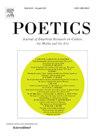公共资助艺术和文化领域的权力、不稳定性和多样性:英国艺术委员会国家投资组合组织分析
IF 1.7
2区 社会学
0 LITERATURE
引用次数: 0
摘要
围绕艺术多样性的问题得到了广泛的研究,揭示了公共资金和资源集中方面的重大不平等。然而,关于文化生产逻辑及其对节目多样性影响的研究却很少。本文使用布尔迪厄场域分析来提供文化生产的组织概述,研究文化组织内关键经济、物质和符号资源的分布如何塑造其规划的多样性。利用英国艺术委员会(ACE)国家投资组合组织(NPOs)的调查数据,我们构建了一个NPO文化生产领域。通过多重对应分析,我们研究了两个关键问题:(1)在非营利组织生产领域内,非营利组织在资源、学科和组织结构方面是如何分布的?(2)非营利组织文化生产领域的职位与面向不同受众的活动规划之间的关联或同源性有多强?由此产生的领域主要受经济弹性和不稳定性以及学科和组织差异的影响。我们的分析显示,规模较大、经济弹性更强的组织对多样性的承诺较低,而这些努力集中在规模较小、经济弹性较弱的组织中。尽管资助机构在战略上呼吁多样性,但文化产品的多样性主要是围绕经济原则构建的。除了针对LGBTQ+的项目外,小型组织似乎比传统机构在迎合传统上被排斥和代表性不足的艺术群体方面承担着更重的负担。本文章由计算机程序翻译,如有差异,请以英文原文为准。
Power, precarity and diversity in the field of publicly funded arts and culture: An analysis of Arts Council England National Portfolio Organisations
Issues around diversity in the arts have been widely examined, revealing significant inequalities in public funding and the concentration of resources. However, studies on cultural production logics and their impact on programming diversity are limited. This paper uses Bourdieusian field analysis to provide an organisational overview of cultural production, examining how the distribution of key economic, material, and symbolic resources within cultural organisations shapes the diversity of their programming. Using survey data from publicly funded Arts Council England's (ACE) National Portfolio Organisations (NPOs), we construct a field of NPO cultural production. Through multiple correspondence analysis, we investigate two key questions: (1) How are NPOs distributed in terms of resources, disciplines, and their organisational structure within the field of NPO production? (2) How strong is the association, or homology, between positions in the field of NPO cultural production and the programming of activities for diverse audiences? The resulting field is primarily shaped by economic resilience and precarity, as well as by disciplinary and organisational differences. Our analysis reveals that larger, more economically resilient organisations show a lower commitment to diversity, while these efforts are concentrated among smaller and less resilient organisations. Despite strategic calls for diversity from funding bodies, the diversity of cultural offerings is predominantly structured around economic principles. Except for programming oriented to LGBTQ+, small organisations appear to bear a heavier burden than legacy institutions in catering to groups traditionally excluded and underrepresented in the arts.
求助全文
通过发布文献求助,成功后即可免费获取论文全文。
去求助
来源期刊

Poetics
Multiple-
CiteScore
4.00
自引率
16.00%
发文量
77
期刊介绍:
Poetics is an interdisciplinary journal of theoretical and empirical research on culture, the media and the arts. Particularly welcome are papers that make an original contribution to the major disciplines - sociology, psychology, media and communication studies, and economics - within which promising lines of research on culture, media and the arts have been developed.
 求助内容:
求助内容: 应助结果提醒方式:
应助结果提醒方式:


